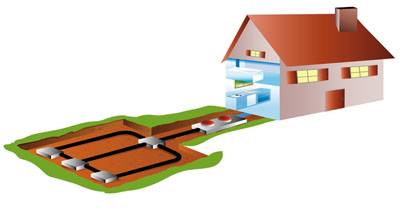
Geothermal heating and air conditioning systems are gaining in popularity, and for good reason. Geothermal heat pumps are not a new idea – they have been in use since the 1940s – but with the recent green movement, more people are gaining awareness of this efficient technology. Here is how it works, and some of the benefits.
Every day, the e arth absorbs solar energy and stores it. This is why the temperature below the earth's surface is relatively constant. Below the frost line, it's warmer underground in the winter. In the summer, it's cooler underground (this is the principle behind root cellars). Geothermal heating and cooling systems make use of this sun-to-earth energy.
There are two main types of heating and cooling systems: closed loop and open loop. Both are based in the principle of the heat pump.
An open loop system actually taps into ground water which is, like the earth underground, at a fairly constant temperature. The water is pumped into the geothermal heat pump where it is warmed, circulated through the dwelling, then returned to the earth or used in other ways in the dwelling. Because the ground water temperature is warmer than the cold, outside air, the heat pump does not have to work very hard to heat the water.
Closed loop systems circulate water and anti-freeze through a closed network of pipes. The pipes are laid underground, beginning and ending at the heat pump in the building's basement. As the liquid in the pipes travels underground, it gets heated or warmed by the pump, depending on the season.
Benefits
The benefits of geothermal heating and air conditioning systems are numerous. For example:
1. Much less electricity is used in the generation of hot or cold air with geothermal systems. Because electricity requires fossil fuels to be produced, this helps reduce the use of such fuels. It also lowers your electric bill.
2. Geothermal systems can save energy and water, too, as the hot water produced in an open loop system can be used in various other household applications.
3. Geothermal systems are said to be much more comfortable. There is much less fluctuation in indoor temperature.
4. There are no visible, above-ground components that make noise and can be unsightly. The geothermal system is underground and in the building's basement.
5. No emissions are produced by geothermal systems.
6. There is a great deal of versatility with these systems. They can be customized for just about any dwelling, even going underground vertically in the absence of horizontal property.

